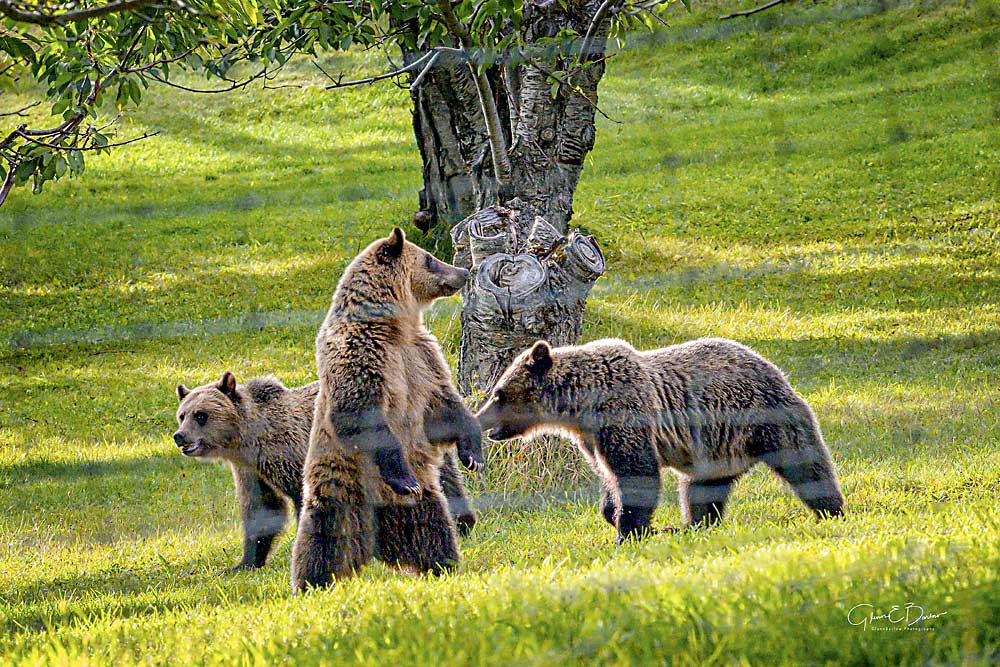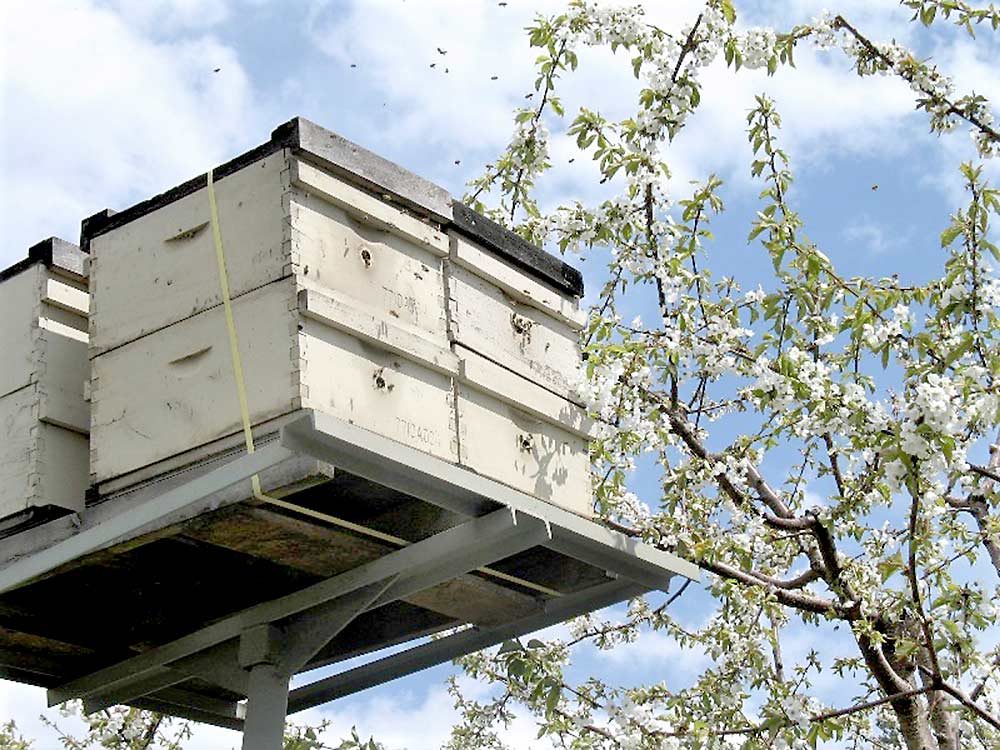
There’s a growing pest problem in many of the country’s fruit regions — one known to tear apart fruit trees, destroy beehives and, if encountered by a human, cause considerably more alarm than a typical bug.
Bears, most commonly black bears, require unique management strategies. If they’re grizzlies, sometimes the only strategy is to hope they never come back.
Michigan
A growing number of black bears in Michigan’s northern Lower Peninsula, combined with a decline in native pollinators, has increased the likelihood of attacks on the commercial beehives growers rely on to pollinate their fruit, said Gary Roloff, a professor with Michigan State University’s department of fisheries and wildlife.
If a bear’s natural foods — berries, acorns and beechnuts, for example — are low, its interest in beehives will go up. And contrary to popular belief, bears aren’t going after honey. They want the energy- and nutrient-rich bee larvae, though they end up eating the queen and honey, too. In the process of getting what they want, they can completely destroy the hive and the physical structure surrounding it, Roloff said.
To prevent that destruction, a barrier is needed — and the barrier has to be 100-percent effective. “One bear visit to a beehive is all it takes,” he said.
Based on his research, Roloff said a small, mobile electric fence is the best way to protect beehives from bears. It’s relatively cheap, easy to install and maintain, and “pretty doggone reliable.” He shared bear management strategies at the 2020 Northwest Michigan Orchard and Vineyard Show in January.
Roloff and an assistant conducted a field test in northern Michigan in 2010 (partially funded by the Michigan Beekeepers’ Association), testing electric fence designs. They baited the bears with circus peanuts and pastries. Once video cameras confirmed an overnight ursine presence, they set up fences around the bait.
They tested four fence designs (each costing roughly $250 to protect a 12-foot by 12-foot area). About 15 bears interacted with the fences, he said.
“We have hours of video footage of really unique bear behaviors,” Roloff said. “I’m convinced they have different personalities. One bear was really aggressive and would shake a conifer to try and scare the fence. Some tiptoe around it, some try to dig under it. The creative ones figure out a way in.”
He has footage of one bear pushing through the electric wires. The wire touching its back didn’t seem to faze the bear, but as soon as the lower wire hit a “sweet spot” on its thigh, the bear ran back out — but tore the fence down as it did so.
“You don’t want that,” Roloff said. “You don’t want the bear to penetrate even that far.”
Based on his research, Roloff said mobile electric fences should include the following:
—Adequate grounding.
—Fiberglass corner posts.
—Highly visible polytape.
—All wires charged to 3,500–7,000 volts.
—A low-impedance fence energizer.
—Regular maintenance to ensure adequate voltage, battery charge and fence structure.
Pacific Northwest
Rudy Prey, owner of Prey’s Fruit Farm and Orchards in Peshastin, Washington, has lived in the north-central area of the state since 1975 and said black bear sightings are far more common than they used to be.
“They seem to be getting closer and closer,” Prey said. “Other growers say this, too.”
Every year during harvest, bears enter his pear orchards from the timberline at night and range throughout, sometimes picking fruit off the ground, but often doing more.
“Once they find the pear trees, they won’t quit,” Prey said. “If they just ate the fruit, it wouldn’t be a problem, but they break the trees down. We probably lose several thousand dollars every year just on trees.”
He said the bears love Asian pears and prefer Anjou and Concorde to Bartlett. If they hear a four-wheeler approaching or other sign of human presence, the bears will run off, but they don’t stay away forever. He’s found that the only way to stop them is an electric fence.
Black bears have been a consistent problem around Flathead Lake in northwest Montana, where most of the state’s cherries are grown.

Brian Campbell, a cherry grower and field representative for Monson Fruit Co., said bears have been known to attack the region’s beehives and orchards. Growers and beekeepers have devised two main methods to protect their hives: placing them on top of a metal pole (12 feet or longer), or surrounding them with an electric fence, he said.
The electric fences are temporary, set up for about three weeks during pollination. Each fence typically has two electric wires: one less than 1 foot off the ground (a bear digging under the fence will hit that wire, often with its nose) and another placed 3 feet off the ground (a climbing bear will hit that one), he said.
Between those two methods, hives in the area are pretty well protected from bears. The real problem is the cherry trees. Campbell has heard “tons of stories” about bears getting into orchards at night.
“If bears see ripening cherries, they will do what they can to take them down,” he said.
Today’s smaller, more tightly spaced cherry trees are especially vulnerable to the kind of damage bears can do, Campbell said.
Most growers already have some kind of fence around their orchards, usually a deer fence. But even a sturdy, 8-foot-tall deer fence is no match for a bear, which can climb over it, dig under it or bust through it. That’s why the fences need to be electrified — usually by adding an electric wire or two. More and more growers are electrifying their orchard fences — a solution that costs money, of course, and requires constant maintenance, but the growing bear problem leaves them little alternative, he said.
It’s a problem for the bears, too, even if they don’t know it. If a black bear gets too comfortable in a human environment and becomes a potential threat, game wardens will move it or euthanize it, he said.
And there’s a new problem. Campbell encountered three young bears on his property in 2019 — grizzlies. A game warden told him they had just been kicked out by their mother, after turning two. The siblings “didn’t really seem to know what they were doing,” roaming around and getting into orchards, he said.
They didn’t do too much damage, but now that they know where the food is, they might come back. And they will be bigger when they do. Campbell got close to the bears (from inside a truck), and even though they were young and not yet fully grown, their size and power had his “skin crawling.”
“They were only 250 pounds apiece this year,” he said. “You get three 800-pound grizzlies roaming around the orchards, it’s not gonna be pretty.”
And because grizzlies are listed as threatened under the Endangered Species Act in the lower 48 states, management tools are extremely limited. You can’t use traps or repellents, you can’t shoot them, and — though it might not be a violation of federal law — “you can’t chase them off with a broom,” Campbell said.
If those three grizzly bears signal a recovering population in the region, that’s an even bigger problem for growers.
“The bears seemed leery of people this year,” he said. “But they’re feeling their oats. They could become more brazen.”
Then, the problem wouldn’t be confined to fruit or beehives. During harvest, cherry pickers often sleep in tents and cook outdoors. Knowing bears are around would make the campers “awfully nervous,” Campbell said, especially if the bears are grizzlies.
“Nobody wants to camp in an orchard with grizzlies,” he said.
—by Matt Milkovich






Leave A Comment